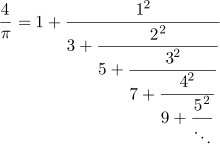Fraction (mathematics)

A fraction is a number that shows how many equal parts there are. When we write fractions, we show one number with a line above (or a slash next to) another number.[1][2] For example, , 1⁄4 and 1/4.are different ways of writing the same fraction (in this case a quarter). The top number tells us how many parts there are, and the bottom number tells us the total number of parts.[3]
Numerators and denominators[change | change source]
The top part of a fraction (example: 1/4) is a numerator. Numerators can be any real numbers. The numerator can be on the top or to the left when writing fractions. The bottom part of a fraction (example: 1/4) is called a denominator. This number cannot be zero. It is on the bottom or on the right when writing fractions.
A proper fraction is a fraction with the numerator smaller than the denominator. An improper fraction is a fraction where the numerator is bigger than the denominator. For example, is a proper fraction, and is an improper fraction.

Examples of fractions[change | change source]
- A room where of the people are girls, has 1 girl for every 4 people.
- A cake can be thought of as being made up of 4 equal parts, where each is 1 part of 4. This can be written as , and is called a "quarter". Similarly, 2 parts of the cake (2 quarters) can be written , which is also equal to 1/2 (one-half).
Mathematical fractions[change | change source]
A fraction is a mathematical expression relating two quantities or numbers, where one divides the other. When the two quantities are whole numbers (or integers), this is called a rational number (such as the fraction ). When the two quantities are polynomials, this is called a rational function.
| 1/2 | 2/3 | 3/4 |
|---|---|---|
| 4/5 | 5/6 | 6/7 |
| 7/8 | 8/9 | 9/10 |
| 10/11 | 11/12 | 12/13 |
| 13/14 | 14/15 | 15/16 |
| 16/17 | 17/18 | 18/19 |
| 19/20 | 20/21 | 21/22 |
| 22/23 | 23/24 | 24/25 |
| 25/26 | 26/27 | 27/28 |
| 29/30 | 30/31 | 32/33 |
| 33/34 | 34/35 | 35/36 |
| 36/37 | 37/38 | 38/39 |
| 39/40 | 40/41 | 42/43 |
| 43/44 | 44/45 | 45/46 |
| 46/47 | 47/48 | 48/49 |
| 49/50 | 50/51 | 51/52 |
| 52/53 | 53/54 | 54/55 |
| 55/56 | 56/57 | 57/58 |
| 58/59 | 59/60 | 60/61 |
| 61/62 | 62/63 | 64/65 |
| 65/66 | 66/67 | 68/69 |
| 69/70 | 70/71 | 71/72 |
| 72/73 | 73/74 | 74/75 |
| 75/76 | 76/77 | 77/78 |
| 78/79 | 79/80 | 80/81 |
| 81/82 | 82/83 | 83/84 |
| 84/85 | 85/86 | 86/87 |
| 87/88 | 88/89 | 89/90 |

Mathematically, a fraction is a quotient of numbers, representing the number's value when the numerator (upper number) is divided by the denominator (lower number). Thus means one divided by two, or, in decimals, 0.5.
To find of , the denominators are multiplied, and because denominator 2 multiplied by 2 equals 4, we have that x = , or 0.5 x 0.5 = 0.25.
(In this case, “ of” means "multiplication".)
To find divided by , multiply by the reciprocal of , which is 2. That answer is 1.
Multiplying[change | change source]
To multiply two fractions, the first numerator is multiplied by the other numerator, and the first denominator is multiplied by the other denominator. For example. 2⁄4 x 3⁄4 = 6⁄16. One can simplify this by dividing both numbers by a common factor. This would be 3⁄8 after the simplification.
Related pages[change | change source]
References[change | change source]
- ↑ "Compendium of Mathematical Symbols". Math Vault. 2020-03-01. Retrieved 2020-08-27.
- ↑ Weisstein, Eric W. "Fraction". mathworld.wolfram.com. Retrieved 2020-08-27.
- ↑ "Fractions". www.mathsisfun.com. Retrieved 2020-08-27.
Other websites[change | change source]
- Curricula for Creating Fractions
- Interactive and dynamic worksheets to visualize fractions
- Worksheets: Identifying Fractions
- Worksheets: Improper Fractions to Mixed Numbers
- Curricula for Teaching about Equivalent Fractions Archived 2020-10-01 at the Wayback Machine
- Free online quizzes about Fractions
- Printable fraction worksheets for elementary grades.




